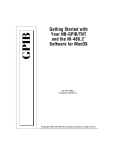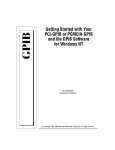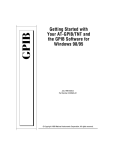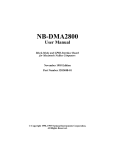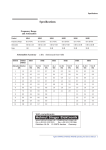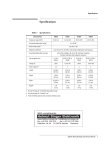Download GPIB-VXI/C User Manual - Helmut Singer Elektronik
Transcript
GPIB-VXI/C User Manual bus June 1994 Edition Part Number 320404B-01 With compliments Helmut Singer Elektronik www.helmut-singer.de info@helmut-singer.de fon +49 241 155 315 fax +49 241 152 066 Feldchen 16-24 D-52070 Aachen Germany © Copyright 1992, 1994 National Instruments Corporation. All Rights Reserved. General Description Chapter 1 The GPIB-VXI/C is factory configured to function as the system Resource Manager (RM). It performs the VXIbus startup configuration, self-test, and initialization functions, as well as VXIbus Slot 0-related services. The RM and Slot 0 functions can be defeated individually so that the GPIB-VXI/C can coexist with another RM and/or be located in any slot. What Your Kit Should Contain Your GPIB-VXI/C kit contains a GPIB-VXI/C module and documentation. The GPIB-VXI/C part number and serial number are printed on the label affixed to its shield casing. Note: The full part number of the GPIB-VXI/C is determined by configuration options corresponding to the extension -XYZM in the part number. The X, Y, and Z options are described below. The M corresponds to the manufacturer. X 68881 coprocessor option 0 without coprocessor 1 with coprocessor Y ROM option 1 user firmware 2 development firmware 3 user firmware and EPROM expansion 4 development firmware and EPROM expansion Z RAM option 1 512 KB 2 1 MB 3 2 MB 4 4 MB With compliments Helmut Singer Elektronik www.helmut-singer.de info@helmut-singer.de fon +49 241 155 315 fax +49 241 152 066 Feldchen 16-24 D-52070 Aachen Germany GPIB-VXI/C User Manual 1-2 © National Instruments Corporation Chapter 1 General Description Optional Equipment You can contact National Instruments to order any of the following cables. • Type S5 serial port cable, 25-pin (2 m) • Type S6 serial port cable, 9-pin (2 m) • Type X2 double-shielded GPIB cables (1 m, 2 m, 4 m, or 8 m) Unpacking Follow these steps when unpacking your GPIB-VXI/C: 1. Verify that the pieces contained in the package you received match the kit parts list. Do not remove the module from its plastic bag at this point. 2. Your GPIB-VXI/C module is shipped packaged in an antistatic plastic bag to prevent electrostatic damage to the module. Several components on the module can be damaged by electrostatic discharge. To avoid such damage while handling the module, touch the plastic bag to a metal part of your VXIbus mainframe chassis before removing the module from the bag. 3. Remove the module from the bag and inspect the module for loose components or any other sign of damage. Notify National Instruments if the module appears damaged in any way. Do not install a damaged module into your VXIbus mainframe. VXIbus Characteristics The GPIB-VXI/C has the following VXIbus capabilities: • • • • • • • • • Fully compatible with VXIbus System Specification VXIbus Resource Manager (RM) (defeatable) VXIbus Slot 0 support (defeatable) VXIbus Message-Based Commander and Message-Based Servant VXIbus master (A16, A24, D16, D08(EO)) VXIbus slave (A16, A24, A32, D16, D08(EO)) Up to 4 Megabytes of dual-ported (shared) memory Three programmable VXIbus interrupt handlers IEEE 488.1 and IEEE 488.2-compatible multiple primary or multiple secondary 488-VXIbus translator © National Instruments Corporation 1-3 GPIB-VXI/C User Manual General Description Chapter 1 GPIB Characteristics The GPIB-VXI/C has the following GPIB characteristics: • Communication with VXIbus Message-Based devices – VXI logical addresses are mapped to GPIB addresses – – • • Interface – NAT4882 and Turbo488 ASICs coupled with DMA – – Full, transparent support of individual status bytes for each GPIB address Buffered operation decouples GPIB and VXIbus operation – Controller can address one VXIbus device to talk and one or more other VXIbus devices to listen IEEE 488.1 capabilities – SH1 (Source Handshake) – AH1 (Acceptor Handshake) – T5, TE5 (Talker, Extended Talker): multiple primary or multiple secondary addressing – L3, LE3 (Listener, Extended Listener): multiple primary or multiple secondary addressing – SR1 (Service Request) – DC1 (Device Clear) – DT1 (Device Trigger) – RL0 (Remote Local) – • Automatically configured at startup Programmable PP0 (Parallel Poll) IEEE 488.2-compatible 488-VXIbus translation The IEEE 488.1 capabilities are supported for all VXIbus devices associated with GPIB addresses. The IEEE 488.2 compatibility applies to 488.2-compatible VXIbus devices associated with GPIB addresses through the GPIB-VXI/C. GPIB-VXI/C User Manual 1-4 © National Instruments Corporation Chapter 1 General Description Local Command Set Overview The GPIB-VXI/C local command set supports the following types of operations: • System configuration and control – Help – – General configuration RM information extraction – – VXI-defined common ASCII system commands Dynamic system configuration and reconfiguration – GPIB address configuration – VXIbus interrupt handler configuration – IEEE 488.2 common commands • Instrument development and test – VXIbus access – Word Serial communication • CI use and development – CI configuration You can access the command set from the GPIB port, the serial port, and through Word Serial Protocol communication. You can also use separate programmable local command response modes for interactive and control program operation. Code Instruments The GPIB-VXI/C can run software modules called Code Instruments or CIs that perform special functions in the VXIbus environment. Typical applications of CIs include: • • • Translating and interpreting command language Creating virtual (hierarchical) instrument Implementing Message-Based interface for Register-Based devices and non-VXI devices CIs can be implemented in three forms: • • • As part of the National Instruments-supplied firmware (Resident CIs, or RCIs) As user-developed downloadable object code (Downloaded CIs, or DCIs) As user-add-on firmware (EPROMed CIs, or ECIs) For more information about CI capabilities and applications, see Appendix A, Code Instrument Overview. © National Instruments Corporation 1-5 GPIB-VXI/C User Manual General Description Chapter 1 Front Panel Features The GPIB-VXI/C has the following front panel features: • Five front panel LEDs – SYSFAIL LED reflects the status of the backplane SYSFAIL* signal and indicates that a VXIbus device in the system has failed. – FAILED, TEST, and ON LINE LEDs indicate the current status of the GPIB-VXI/C. – ACCESS LED indicates when the GPIB-VXI/C is accessed from GPIB or VXIbus or when its MODID is asserted. • Five front panel connectors – GPIB interface – Serial port – – – • Trigger input Trigger output External CLK10 I/O Configurable reset pushbutton – Pushbutton resets backplane – Pushbutton resets GPIB-VXI/C – Pushbutton resets both backplane and GPIB-VXI/C GPIB-VXI/C User Manual 1-6 © National Instruments Corporation Chapter 2 Configuration and Startup Procedures This chapter contains information about the system configuration, GPIB-VXI/C configuration, and startup operation. System Configuration The typical system includes the following components: • A VXIbus system mainframe containing the GPIB-VXI/C and instrument modules • A host computer with a GPIB interface module and associated driver software (available for many computers from National Instruments) connected to the GPIB-VXI/C GPIB port • A dumb terminal or host running a terminal emulator connected to the GPIB-VXI/C serial port (optional) The serial port settings are 9600 baud, 8-bit data, no parity, and one stop bit. Refer to Appendix D, Connectors, for descriptions of the RS-232 serial connector and the GPIB interface connector. Cables for connecting the GPIB-VXI/C serial port to an RS-232 terminal or COM1 port on an IBM PC-compatible computer are available from National Instruments (see Optional Equipment in Chapter 1). © National Instruments Corporation 2-1 GPIB-VXI/C User Manual Configuration and Startup Procedures Chapter 2 GPIB-VXI/C Configuration The GPIB-VXI/C factory configuration is shown in Table 2-1. The RAM, firmware and coprocessor are configured according to the GPIB-VXI/C purchase options. Table 2-1. GPIB-VXI/C Factory Configuration Function Factory Configuration Startup Mode 488-VXI Runtime System Mode VXIbus Characteristics Resource Manager (RM) Logical Address Servant Area Size Shared Memory Address Modifiers Enabled 0 0 0% of Installed Memory Supervisor A16, Supervisor A24 data VXIbus Slot 0 Services CLK10 Driver CLK10 Source SYSCLK Driver Priority Arbiter Bus Timeout Enabled Onboard Clock Enabled Enabled Enabled (BTO ≥ 250 μsec) Bus Requester Level 3 VXI Interrupt Handlers Unassigned GPIB Addressing Mode Multiple Secondary Addressing GPIB-VXI/C GPIB Primary Address 1 Serial Port System Startup Messages Console Local Command Port Discrete Fault Indicator (DFI) Disabled Enabled Normally Open Front Panel BNC Termination External Clock Input External Trigger Input Unterminated Unterminated You do not have to change the GPIB-VXI/C factory configuration to use it as a Slot 0 Resource Manager. The following pages describe the factory configuration settings and present alternate configurations. Figure 2-1 shows the location of the GPIB-VXI/C configurable components and their physical location relative to some of the major circuit components. The jumpers and switches are represented in their factory default positions. Note: The GPIB-VXI/C is housed in a metal enclosure that has cut-outs for access to all switches and jumpers associated with Slot 0/Non-Slot 0 settings, start-up mode, and Shared RAM settings. Under normal circumstances, you should not find it necessary to open the enclosure. GPIB-VXI/C User Manual 2-2 © National Instruments Corporation Configuration and Startup Procedures Chapter 2 Setting the Logical Address, GPIB Primary Address, and Servant Area Size You can change the logical address, GPIB primary address, and Servant area size by running the nonvolatile memory configuration utility as described in the Change Configuration Information section of Chapter 4, Nonvolatile Configuration. Verifying the Installed RAM Size Up to 4 megabytes of local RAM can be factory-installed on the GPIB-VXI/C. The minimum amount of memory is 512 kilobytes. Table 2-2 lists the RAM configurations and their associated switch settings. You can use this information to verify the board configuration. Table 2-2. Installed RAM Configuration Installed Memory Size Switch S7 Setting Switch S5 Setting Jumper W6 Setting 512 kilobytes OFF OFF OFF 1 megabyte OFF ON OFF 2 megabytes ON OFF ON 4 megabytes ON ON ON Table 2-3 shows the relationship between the amount of installed memory, the local address range occupied by the memory, and the range of VXI A24 addresses accessible by the GPIB-VXI/C as a bus master. Table 2-3. GPIB-VXI/C CPU Local and A24 Memory Ranges Installed Memory Size Installed Memory Local Address Range Accessible VXI A24 Address Range Start End Start End 512 kilobytes 000000h 07FFFFh 080000h E7FFFFh 1 megabyte 000000h 0FFFFFh 100000h E7FFFFh 2 megabytes 000000h 1FFFFFh 200000h E7FFFFh 4 megabytes 000000h 3FFFFFh 400000h E7FFFFh GPIB-VXI/C User Manual 2-4 © National Instruments Corporation Chapter 2 Configuration and Startup Procedures Setting the Shared Memory Size You can set the amount of installed memory that is shared with the VXIbus by altering the settings of switches S8 and S6. Table 2-4 gives the S8 and S6 switch settings for sharing various portions of RAM with the VXIbus for each possible installed memory configuration. Table 2-4. Shared Memory Switch Settings Note: Amount of Installed Memory Shared with VXIbus Installed Memory Size S6 ON S8 ON S6 ON S8 OFF S6 OFF S8 ON S6 OFF S8 OFF 512 kilobytes 512 kilobytes 256 kilobytes 128 kilobytes none 1 megabyte 1 megabyte 512 kilobytes 256 kilobytes none 2 megabytes 2 megabytes 1 megabyte 512 kilobytes none 4 megabytes 4 megabytes 2 megabytes 1 megabyte none The RAM shared with the VXIbus will be the upper portion of the installed memory. The GPIB-VXI/C Offset Register holds the shared memory VXI A24 base address, as described in the VXIbus specification. The RM automatically configures the Offset Register at startup. Setting the Reset Operation The GPIB-VXI/C has three configurable reset parameters. They can be enabled or disabled and are as follows: • • • Pushbutton resets backplane (asserts SYSRESET* signal). Pushbutton resets GPIB-VXI/C (asserts local reset signal). Backplane SYSRESET* signal resets GPIB-VXI/C (SYSRESET* on backplane asserts local reset). The reset parameters can be altered by the nonvolatile memory configuration as described in the Change Configuration Information section of Chapter 4. With compliments Helmut Singer Elektronik www.helmut-singer.de info@helmut-singer.de fon +49 241 155 315 fax +49 241 152 066 Feldchen 16-24 D-52070 Aachen Germany © National Instruments Corporation 2-5 GPIB-VXI/C User Manual












